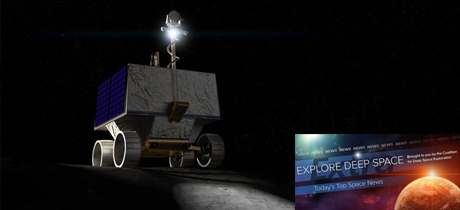In Today’s Deep Space Extra… NASA’s efforts to resume the human exploration of the Moon will mean much for Houston and the Johnson Space Center (JSC). China’s Yutu-2 lunar rover offers surprising lunar soil discovery. In a space first, two commercial satellites link in Earth orbit, a step toward extending the operational lifespan of satellites with robotic refueling and repairs and reducing orbital debris.
Space Science
China’s rover finds layers of surprise under Moon’s far side
New York Times (2/26): China’s Chang’e 4 lander and Yutu 2 rover were the first spacecraft to achieve a landing on the Moon’s far side in January 2019. Results of findings published Wednesday in the journal Science Advances suggest the lunar south pole regolith at the surface level is more uniformly granular, porous and of greater depth than expected, with a few large rocks mixed in. The find suggests a history of history of lunar impact and volcanism. The findings were made with a ground penetrating radar instrument, which will also be aboard rover missions being readied for launch to Mars this summer by NASA, Europe/Russia and China.
NASA seeks bids to deliver VIPER lunar lander
SpaceNews.com (2/26): NASA announced February 25 it was asking the 14 companies that are part of the Commercial Lunar Payload Services (CLPS) program to bid on a task order for sending the agency’s Volatiles Investigating Polar Exploration Rover (VIPER) mission to the lunar poles. VIPER, formally announced by NASA last October, will examine regions at either the north or south pole of the moon thought to contain deposits of water ice. Such deposits, if confirmed, could become critical resources for future human missions.
NASA’s VIPER Moon mission to seek out lunar water slips to 2023
Space.com (2/26): About the size of a golf cart, NASA’s VIPER lunar rover is to continue efforts to locate water ice in permanently shadowed craters of the Moon’s south pole. Lunar ice could serve as a life support asset for human explorers and a source for liquid hydrogen and oxygen rocket fuels sometime in the future. Plans to launch VIPER in late 2022 have slipped to 2023 in order to equip the rover with upgrades that will permit it to explore further and longer, NASA announced this week. The lunar rover will be launched by a NASA Commercial Lunar Payload Payload Services provider.
Op Eds
Is NASA ready to find life beyond Earth?
SpaceNews.com (2/26): NASA needs a new division within its Science Mission Directorate (SMD) devoted to the search for life beyond the Earth, writes Nicholas E. White, a George Washington University research physicist and previous director of science at NASA’s Goddard Space Flight Center. The focus could spring from science enabled by human exploration and enrich planetary protection, he suggests. “It presents an opportunity to raise the tide to lift all boats. This will prepare NASA and the public not just for the first discovery of life beyond the Earth, but for what follows,” he explains.
NASA gets ready for a new generation of human exploration in space, right here in Houston
Houston Chronicle (2/26): In an op-ed, NASA Johnson Space Center (JSC) Director Mark Geyer offers a favorable outlook for Houston under the terms of the agency’s proposed $25.2 billion budget, a 12 percent increase, for 2021. JSC is home to NASA’s astronaut corps, Mission Control and serves as the lead design bureau for human spacecraft.
Other News
From a farside first to cislunar dominance? China appears to want to establish ‘space economic zone’ worth trillions
SpaceNews.com (2/26): Just over a year ago China claimed the first success at landing a spacecraft mission on the Moon’s far side at the south pole. Could that lead to China’s dominance of cis-lunar space and become the cornerstone for a $10 trillion annual economy for China by the middle of the century? The claim’s possible origins range from the Chinese Communist Party to the China Aerospace Science and Technology Corporation, according to speculation.
A Meeting in orbit demonstrates a space junk solution
Coalition Member in the News – Northrop Grumman
New York Times (2/26): Launched in October, Northrop Grumman’s Mission Extension Vehicle-1 (MEV) succeeded Wednesday in docking with its target, the nearly 19-year-old Intelsat-901 communications satellite for a checkout and transfer from a graveyard orbit to a lower operational geostationary orbit to resume service in March. A second MEV mission advancing satellite upgrade technologies is planned for launch later this year.

